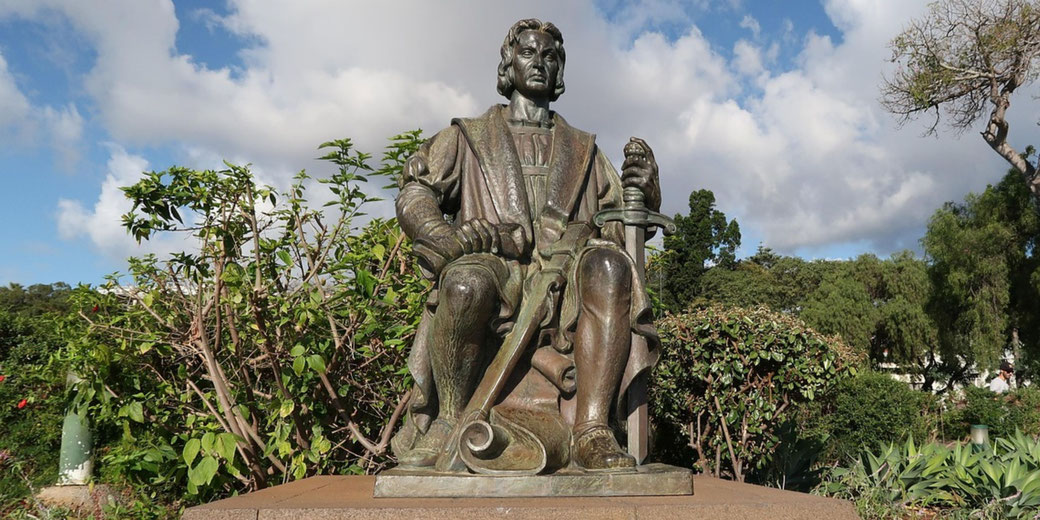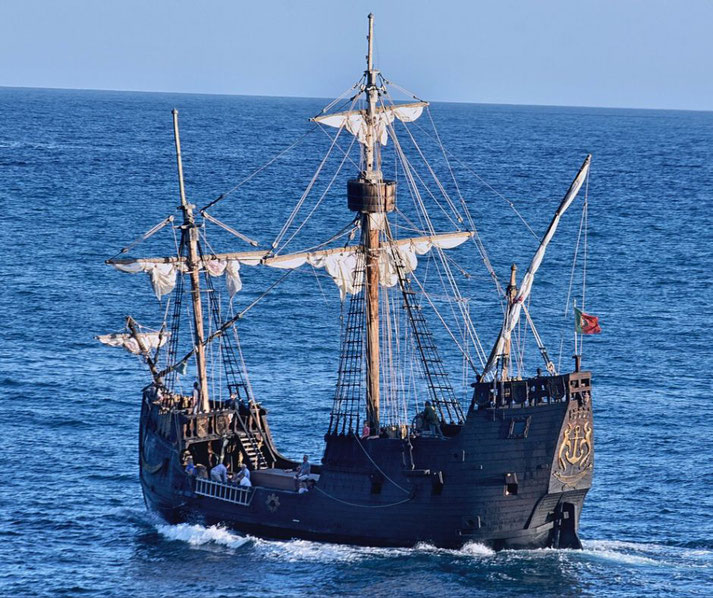Was Christopher Columbus a hero or a villain?

For centuries, Christopher Columbus remained a celebrated figure thanks to his crossing of the Atlantic in 1492. He was convinced that he had reached the eastern edge of Asia, and that he had connected the two great hemispheres of the known world: east and west.
In fact, he brought European expansion to lands that had remained unknown to those across the ocean. As a result, generations of modern schoolchildren learned about his achievements, statues honored him in major cities, and his name appeared on national holidays.
However, the legacy he left behind has become increasingly worrying.
What was Columbus looking for?
During the late fifteenth century, European kingdoms were searching for new trade routes that could bypass the overland networks controlled by the Ottoman Empire.
The expensive exotic items of spices and silk drove this competition, which was dominated by Portugal’s successful ventures along the African coast.
Christopher Columbus was an experienced mariner from Genoa and believed he could reach Asia by sailing west across the Atlantic.
We know that his calculations underestimated the Earth’s circumference, but he remained convinced that his plan would provide Spain with an advantage in the lucrative spice trade.
For years, he presented his proposal to various courts, including Portugal’s, which rejected his request for ships and funding.
Then, in 1492, Columbus gained the support of Spain’s Catholic Monarchs, Ferdinand and Isabella.
Their recent victory in the Reconquista, which had expelled Muslim rule from the Iberian Peninsula, allowed them to focus on new overseas ambitions and they agreed to fund Columbus’s expedition under the terms of the Capitulations of Santa Fe.
These granted him titles and a share of any wealth he acquired. He received three ships—the Niña, the Pinta, and the Santa María—and departed from Palos de la Frontera on August 3, 1492.
After weeks at sea, he sighted land on October 12: an island in the Bahamas, which he named San Salvador.
Expecting to find the riches of Asia, he encountered the Taíno people, who were unfamiliar with European weapons and customs.

During his second voyage in 1493, Columbus returned with a larger fleet of seventeen ships, carrying settlers, livestock, and supplies which he intended to use to establish permanent colonies that Spain could use as bases for further exploration.
When he arrived at La Navidad, a settlement he had left behind on Hispaniola, he found it destroyed.
It had been caused by an ongoing conflict between the Spanish and the local population. In its place, he founded new settlements, including La Isabela, but his strict rule over both colonists and Indigenous people caused tension.
Reports of harsh punishments and forced labor reached Spain, which led to growing criticism of his administration.
His third voyage in 1498 expanded his exploration beyond the Caribbean islands.
He reached the coast of South America, which he mistook for another island, and observed the mouth of the Orinoco River.
This discovery led him to believe that there was a much larger landmass than he had originally anticipated.
This, unfortunately, complicated his belief that he had reached the fringes of Asia.
Meanwhile, unrest among Spanish settlers in Hispaniola led to his sudden arrest in 1500 and his removal as governor due to his ‘misrule’.
He returned to Spain in chains, which was a humiliating outcome for a man who had expected royal recognition.
His final voyage in 1502 took him to Central America, where he searched for a passage to the Indian Ocean.
He encountered hostile resistance from local inhabitants and faced dangerous storms, which damaged his ships.
Stranded in Jamaica for months, he relied on deception to manipulate the Indigenous people into providing food and, by the time he returned to Spain in 1504, his influence had diminished significantly.
It left him without power or wealth and, when he died in 1506, he was still convinced that he had reached Asia.
Columbus' 'heroic discovery’ of the New World
Columbus’s arrival in the Caribbean in 1492 allowed Spain to establish a foothold in territories and led to a wave of exploration, which brought new territories into Spanish control and created the conditions for European colonization.
Following this, Spain dispatched further expeditions to explore and claim lands across the Americas.
His voyages demonstrated the possibility of sustained transatlantic travel, and this motivated a range of other European nations to finance their own explorers.
Portugal, England, and France soon followed, which transformed the Atlantic into a contested space for exploration and trade.
It is as a result of this global impact that Columbus became so famous for so long. Crossing the Atlantic required skillful seamanship, which he had developed through years of experience sailing in the Mediterranean and along the African coast.
His ability to estimate distances, maintain course, and manage a constantly restless crew contributed to the success of his first voyage.
As a consequence of his persistence, European powers recognized the viability of westward exploration.
Due to his discoveries, Spain gained access to immense natural resources, which increased its wealth and power in the sixteenth century.
His efforts established vital trade routes that connected Europe with the Americas, which allowed for the transfer of goods, ideas, and technologies.
This led to the emergence of the Columbian Exchange, which transformed agriculture, commerce, and diets across continents.
Thanks to these connections, European economies flourished, and Spain became the leading global power of the era.
As a consequence of his voyages, Columbus gained widespread admiration among his contemporaries.
Many saw him as a courageous explorer who accomplished what others had failed to achieve.
His name appeared in royal documents, letters, and histories that praised his navigational expertise.
Following this, later historians continued to regard him as the pioneer of the Age of Exploration.
Harbinger of destruction? The case against Columbus
Because Columbus arrived in lands already inhabited by Indigenous societies, his achievements quickly led to violent disruptions that transformed their way of life.
Specifically, his demand for gold and resources forced the Taíno people of Hispaniola into brutal labor systems that extracted wealth for Spain.
The encomienda system, which he implemented, required Native populations to mine gold and provide food for Spanish settlers.
Those who resisted faced severe punishments. This often included mutilation and execution and, according to firsthand reports, thousands suffered under these conditions.
Entire villages collapsed from overwork and malnutrition. In fact, within two decades, the Taíno population declined from an estimated 300,000 to fewer than 30,000 due to exploitation and abuse.
As a consequence of increased European contact, unfamiliar diseases spread rapidly through the Americas as well.
Native populations lacked immunity to smallpox, measles, and influenza. This meant that outbreaks killed millions within a single generation.
The first recorded epidemic on Hispaniola occurred in 1518, which resulted in an immediate collapse of local societies.
Scholars estimate that 90% of the Indigenous population in the Caribbean perished within the first century of Spanish colonization.
These losses exceeded those caused by war and enslavement, which accelerated the decline of entire civilizations.
In fact, later conquests of larger cultures, like the Aztec, relied on the devastation caused by disease, which made resistance impossible in many regions.
Even more, under Columbus’s rule as governor, enslaved labor became a standard method of exploitation, which contributed to the origins of the transatlantic slave trade.
Due to the rapid population decline on Hispaniola, he authorized the capture and shipment of Native people to Spain, which introduced large-scale Indigenous slavery into European markets.
In fact, he personally sent 500 captives to Queen Isabella in 1495. This established a precedent for future colonial expansion.
As the supply of enslaved Indigenous labor decreased, Spanish authorities turned to African slavery, which became a central part of their growing economy.
By the mid-sixteenth century, over 12 million Africans were forcibly transported to the Americas.
Because he ruled with strict and often cruel measures, Columbus also mistreated Spanish settlers, which led to his eventual downfall.
Specifically, he imposed severe punishments on those who opposed his authority, which included public executions and mutilation.
His decisions created deep resentment among colonists. This prompted complaints to the Spanish Crown. This is what led to his arrest in 1500.
Official reports from the Spanish court described his administration as unjust and oppressive, and directly led to a loss of favor, and forced him to spend his final years attempting to regain royal support.
Why do some people celebrate Columbus, while others reject him?
Because Columbus represented the spirit of exploration, American leaders embraced his image as a symbol of national identity.
During the late nineteenth century, growing waves of Italian immigration led to efforts to recognize his contributions, which helped integrate Italian Americans into mainstream society.
In 1892, the 400th anniversary of his first voyage inspired nationwide celebrations.
As a result of these efforts, Columbus Day became a federal holiday in 1937.
Politicians praised his bravery, which aligned with the ideals of ambition and perseverance that defined American expansionism.
However, as historical research uncovered evidence of forced labor and violence, Indigenous communities began to challenge the positive portrayal of Columbus.
Over time, this led to the emergence of Indigenous Peoples' Day. During the late twentieth century, Native American activists organized protests, which exposed the darker consequences of European colonization and, in 1992, the quincentennial anniversary of Columbus’s arrival in the Caribbean, there was an official recognition of Indigenous Peoples’ Day in several states.
Local governments replaced Columbus Day with alternative observances, which acknowledged the suffering of Native populations.
As a result of continued activism, cities across the United States removed statues of Columbus.
During the late twentieth century, historians examined firsthand accounts from Columbus’s expeditions.
Their research contributed to a broader reexamination of European colonization, which challenged traditional narratives that had celebrated European explorers.
As a result, educators introduced more critical perspectives into high school curricula, which encouraged students to evaluate primary sources and question national myths.
As these perspectives gained influence, public debates over Columbus’s legacy intensified, which fueled political disagreements over how history should be presented in schools and public spaces.
Today, most historians argue that it is possible to praise Columbus’ achievements while also admitting the negative impacts of his discoveries.
What do you need help with?
Download ready-to-use digital learning resources
Copyright © History Skills 2014-2025.
Contact via email
With the exception of links to external sites, some historical sources and extracts from specific publications, all content on this website is copyrighted by History Skills. This content may not be copied, republished or redistributed without written permission from the website creator. Please use the Contact page to obtain relevant permission.





